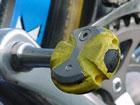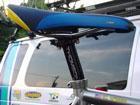Tech news for August 30, 2001By John Stevenson Got tech? Send press releases, news, and tech questions to the Cyclingnews tech-heads. Kirk
O'Bee's Litespeed In the pitsKirk O'Bee's Litespeed Ultimate
After we ran a pic of Kirk O'Bee's bike a couple of weeks ago (when he won the USPro criterium championships), Navigators team mechanic Mike Spilker dropped us a line pointing out that the shot was actually of Kirk's spare bike and not of his main ride. To prove the point, Mike sent us these shots of O'Bee's actual race-winning bike, and very droolsome it is too.
The Ultimate is clearly designed for the aggressive, attacking style of racing that characterises the US criterium circuit, with a back end so tucked-in the seat tube is modified to accommodate the rear tyre. Mike is highly impressed with the durability of the Litespeed's work: "†I have worked with the team for 3 years now. I have not had to send a frame back for being cracked yet. When I visit other team trucks here in the states they have 'spare frames' strapped to their roof in case they have to replace a frame. This is a problem I don't have to worry about." Asked if the frames are stock or custom, Mike says, "Kirk's Litespeed, Ultimate and all the parts are stock (off-the peg). We only have one custom made road bike on the team (Vassilli Davidenko's). †Also, a few of our TT bikes, the "Blades", are custom made. Adham Sbeih's is an example of the TT bike. It is completely custom with the 3 inch bladed tubes.†It's a beautiful machine. They are all beautiful machines." More information: Litespeed's website | |||
Up frontThe Navs use Stella Azzurra bars, stems and tape and Reynolds carbon fibre forks. Stella Azzurra's Tecno-Spugna tape is available in five different densities for absolute fine-tuning of the bike's feel at the bars, and the Profi handlebar is shaped from 7075 aluminium for strength and light weight. It's available with 26mm and 31.75mm centres. Between bars and wheel, the Reynolds OuzoPro fork has a claimed weight of just 350g. As you can also see in this shot, the bikes use Shimano brakes, and, in fact, Shimano transmissions too. However, Shimano's not a team sponsor: there's a purely practical reason for the choice: "The choice of Shimano is based on the fact that the parts are very accessible here in the States.†If our riders have a problem with a part, and I am not around to fix it, they walk into most shops and their problems can be fixed or a new part installed that day. "We are hoping that the door for full sponsorship will be open to Shimano or Campagnolo this next year. We have had a very good year with results in 3 National Championships. I hope this leads to more doors being opened for the team... †and we do have many Italian parts already on our bikes. "I talk to my bikes a lot (I know it's weird). Maybe next year, I can learn to speak Italian to our components. The Japanese language is some times hard to speak." More information: Stella Azzurra 's website More information: Reynolds' website | |||
Watching the wheelsO'Bee rolls on Cane Creek Crono Carbon wheels held in place with Salsa Flip-off skewers. The wheels use weight-saving titanium spokes (16 up front, 20 in the rear) and have the nipples at the hub to take them out of the faster-moving airflow round the rim. Throw a deep carbon fibre rim into the mix and you've got one slippery pair of wheels. As for the skewers, the Salsas' beefy levers means they aren't the lightest around (though we're talking grams here) but they are among the nicest to use, and when you spend half your life fitting and removing wheels, that makes a difference. More information: Cane Creek's website More information: Salsa's website | |||
Count ZeroSpeedplay has always danced to a different drummer from other pedal makers, effectively putting its engagement mechanism on the shoe and leaving the pedal as a very minimal component. The Zero pedal is an evolution of Speedplay's long-standing X pedal system, offering adjustable float (between zero and 15 degrees) as opposed to the X pedal's unlimited float, and on-the-bike adjustment. More information: Speedplay's website | |||
Is it bent?No, it's a Thomson Laid back, and it's supposed to look like that. It's also very light and, because the bottom of the clamp is part of the post, very strong. But it does look slightly odd, and Mike says, "Kirk's post is really low in the frame. On the other team bike's that have the laid back post, you can normally see the set back and it does not look so odd.†He probably should be on a bike one size smaller.† Maybe next year… he seems to be going well on this set up." More information: Thompson's website | |||
Forza!If the threadless revolution has done one thing, it's encouraged stem makers to think outside the square when it comes to materials and shapes. Slavish imitation of Cinelli was all very well in its day (and that company made — and makes — some lovely stuff) but there's only so many rounded aluminium stems a geek can take, before wandering off to drool over a stem like the Stella Azzurra Razzo. Forged from magnesium alloy, then CNC-machined to its final shape and smothered in deep, dark anodising to protect the volatile but light metal, it's a stark and angular work of art. Titanium bolts are the finishing touch. Mike has nothing but praise for the company: "In my three years with the team, until now, stems have been our downfall. In 1999, I told our old sponsor that we where having serious issues with the stem. The bars where slipping and the new design was not safe. They said to try a couple of things that helped but did not take care of the big problems.†Then, they blew me off when I kept going after the issues. "Then it happened, a stem failed in dramatic fashion. Broken collar bone, big photo in Velonews, nationwide recall, and lost sponsor. † "In 2000, we switched sponsors.†But they did not have stems to give us, so I had to drive 5 hours, to a friend's shop (thank you Sham), †to custom make stems for the next day. The stems were made for mountain bike bars, so we had to drill them to work for the team.† "Then 2001 rolls around. We have Stella Azzurra come on board. At first, I am thinking to myself, 'a new company… new problems.' I could have not been any farther from the mark. The first prototype stem we get, I put on. It cracks. I send a digital photo and a drawing to my boss that evening, 6:00pm, describing what is happening. Three hours later he forwards the information to Stella Azzurra in Italy.†The next morning, 12 hours later, anew design was done, made, and tested. The design was e-mail to me to look at, with a request of how many and what sizes did I need.†Problem fixed in 12 hours on the other side of the world. That was such an incredible thing for Stella Azzurra to do… I have full faith in Stella Azzurra, plus their bar tape is indestructible." More information: Stella Azzurra's website | |||
Full SpecificationFrame: Stock Litespeed Ultimate, 3.45lbs (1,570g) Group: Shimano Dura Ace Wheels: Cane Creek Crono Carbon, 575g front/868g rear |
Stem: Stella Azzurra Razzo Magnesium Alloy, 155g, titanium bolts Pedals: Speedplay New "Zero", 0-15 degree float, 164g Brake Pads: Kool Stop Ceramic (green) | ||
SnippetsNew from fi’zi:k
Italian saddle maker fi’zi:k claims their newest model, the Aliante, is the most comfortable lightweight saddle ever. Tipping the scales at a mere 160g (claimed weight) it certainly qualifies on the gram count. Fi’zi:k says it hits the comfort mark too thanks to a hull that uses two different carbon fiber weaves to provide flex and strength. And if you doubt the integrity of carbon fiber rails, fi’zi:k says the Aliante's rails are "multi-directional woven carbon fibers reinforced with a tubular aluminum grooved wrap at the clamp area to both protect the carbon rails and to provide a positive grip with the clamp." The practical upshot is that even if the rails fail, they don't fail catastrophically and dump you on the seatpost. The Aliante will be available late September and is expected to retail for US$180. There will be versions with black leather and 'ice blue' Nytek covers. More information: fi’zi:k's website | |||
LettersUCI minimum weight restrictionsLast week, Sean Lally from England and I disagreed about the UCI's weight restrictions on bikes (and I have to confess that as a gear freak, I was playing Devil's advocate — I'd love to see even fancier and lighter bikes but I can also see good reasons for restrictions to keep the playing field level, affordable and safe). We had several letters on this subject, and I'll let Sean have the first response:
The UCI did get some support, though (and that may be a record in itself):
Actually, you do hear of pros breaking equipment, sometimes in the scariest ways. For example, take a look here at the bike that fell apart under Jay Sweet at last year's world's. During the ultralight fad that swept mountain biking in the early 90s, we used to ask what you owned after you'd had a Ritchey P-23 for a year? Two Ritchey P-11 1/2s. (In fairness to Ritchey, only the first incarnation of that bike had problems — later ones were fine.) This writer agreed with Sean:
As with many sporting regulations, this comes down to what's intended against what's feasible. Tracking the cost of every bike in the peloton requires a burdensome bureaucracy; tracking the weight requires a set of accurate scales. Finally on this subject, here's a pleasing suggestion for a compromise system:
BigMAT's LooksWe also had several letters in response to our request for more information about the apparently aluminium frame of some of BigMAT's Look bikes.
And Mark Adams wrote to point out that there are aluminium frames on Look's website. There are, but they get 'lower billing' than the carbon bikes, and I was curious to hear if anyone knew of a high end Look project in the offing. We've asked Look what they're up to, and we'll let you know next time. | |||






